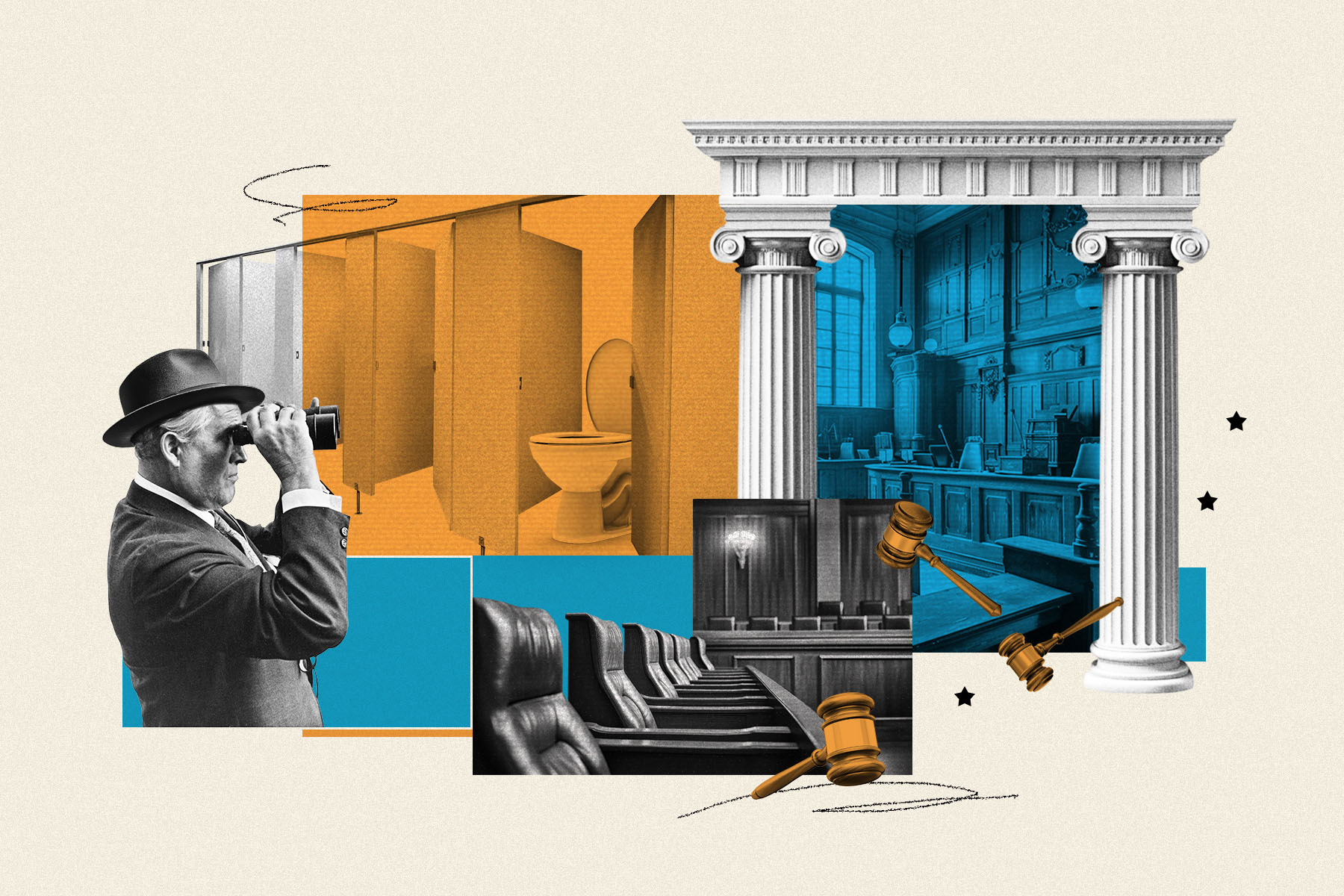Member support made it possible for us to write this series. Donate to our nonprofit newsroom today to support independent journalism that represents you.
Gunner Scott had a simple solution to making sure he had a trans-friendly bathroom when he served as a juror in Boston: Every day at lunch he left the building.
The year was 2009 and the Suffolk County Superior Court where Scott served as a juror for five days didn’t have a gender-neutral restroom. So, on his break, Scott walked up the street to his office.
“I heard one too many stories,” said Scott, who is a longtime transgender advocate.
The stories were about trans people being assaulted and harassed in bathrooms. Scott was not confident he could pass as male in a men’s room in 2009. More than that, his activism had made him a known public figure in the city. He feared someone would recognize him and target him for being trans and using a men’s restroom.
But over the years, as states have started to block trans people from using bathrooms and participating in other areas of public life, courtrooms have moved in the opposite direction by trying to make facilities available to people of all genders, experts say.
That movement is not only key to providing a roadmap for inclusivity for the nation. It also ensures that juries reflect the general population and that everyone gets the opportunity — or burden, in some cases — of serving on them.
Courtrooms may illustrate practical solutions to access as the nation grapples with increasing trans visibility and more traditional ideas about the safety and comfort of a larger public.
The issue of transgender accessibility in courts is a chapter in a longstanding fight for civil rights for LGBTQ+ Americans, prime targets of far-right legislation and discourse these days. The Equality Act, which bars discrimination on the basis of sexual orientation and gender identity, was first introduced to Congress 50 years ago but has never been passed into law. While its first draft only protected gay Americans, subsequent iterations have aimed to shield trans Americans from bias.
The Equality Act specifically mentions jury selection. The bill bans lawyers from striking queer jurors because they are LGBTQ+. Last year, Sen. Jeanne Shaheen of New Hampshire introduced a standalone bill to the same effect. Reps. Becca Balint of Vermont and Lizzie Fletcher of Texas are sponsoring the measure in the House, where it is unlikely to pass, at least while Republicans are the majority.
Balint told The 19th that courtroom accessibility is key to ensuring that jury pools reflect the makeup of the country.
“We need every American who is eligible to serve on a jury to be in the jury pool,” Balint said. “Conversations change concerning LGBTQ people when LGBTQ people are in the room, and when you exclude people from the judicial process, it makes the system inherently less free and less fair.”
Jury service and the belief that jurors should reflect the nation’s diversity is a closely held American belief today. Historically, though, juries were defined by their exclusivity. For centuries, women were banned or discouraged from jury duty because they were believed to be too fragile to handle criminal trials or deemed “the center of home and family life,” as stated in a 1961 Supreme Court ruling. Fourteen years later, the court ruled in Taylor v. Louisiana that systematically excluding them violated a defendant’s rights to a representative jury. But it wasn’t until 1994 that a decision around the Equal Protection Clause of the 14th Amendment specifically prohibited using gender to strike potential jurors.
Black Americans were barred from service due to slavery and after its abolition, discrimination. Even after the Civil Rights Act of 1875, which prohibited race-based jury selection, many states failed to enforce anti-discrimination protections, leading to lopsided convictions against people of color, a legacy that continues.
LGBTQ+ advocates have long argued that LGBTQ+ Americans, who face increased rates of hate violence and discrimination, also need federal protections to safeguard their presence in juries.
In legally recognizing trans people, states have faced increasing pressure to make government facilities accessible to them. In 2015, then-Boston Mayor Marty Walsh made headlines when he signed an executive order requiring gender-neutral bathrooms at City Hall.
Many courthouses have also installed gender-neutral options or found workarounds that allow trans and nonbinary people to safely use the court, say experts. The difference is that the change has largely gone unnoticed.
Ezra Young, a constitutional scholar and professor in New York, said he has seen even the most conservative courts put in extra effort to allow trans people bathroom access.
“I think one of the benefits of a judiciary is certain things about the very administration of the buildings aren’t really politicized,” Young said. “It’s under presumption that courts need to be generally accessible to people.”
Quite simply, the judicial system has no choice.
“Courts have a constitutional responsibility to make sure that courts are generally accessible to the public and specifically to people who need to use the court,” Young added.
Bathrooms have long been contested public spaces for marginalized groups, and courtrooms have not been immune. That means transgender access is not the first challenge facing court facility managers.
“Some of them didn’t even have women’s bathrooms until quite recently. Usually when reconstruction for bathrooms is done, they try to make sure things are accessible,” Young said.
Sandra Day O’Connor, the first woman to serve on the Supreme Court, encountered that problem in 1981 when she was sworn in.
“[The bathroom] was a long way down the hallway, so it wouldn’t have been convenient,” she told NPR in 2013. “And we had to find something in the way of a restroom that was near the courtroom that I would be able to use when we were back there or in the room where we discussed cases.”
Government buildings have undergone similar upgrades to make bathrooms accessible for people with disabilities since the Americans with Disabilities Act of 1990. Courthouses also reconfigured racially divided bathrooms and courtrooms in the wake of desegregation during the civil rights movement.
Now, all-gender access is the next goal for many municipalities. Nearly half of states (22 plus Washington D.C.) allow residents to opt for “X” gender markers on their state ID cards, and the federal government has been issuing “X” gender markers on passports for two years now. Just three states bar trans people from updating their IDs post-transition.
In Los Angeles County, officials have worked to ensure that every courthouse has a gender-neutral bathroom, according to a spokesperson for the superior court of the county.
“The Court supports inclusivity and seeks to expand access to justice by identifying and addressing barriers — substantive, procedural, physical and in appearance —that may inhibit full participation in the judicial process,” the court said in a statement.
In Cook County, which encompasses Chicago and has one of the world’s largest judicial systems, officials are engaged in research and design plans to add gender-neutral bathrooms to all of its courts. Such facilities already exist at the main courthouses for criminal court, domestic violence, juvenile cases and in the city branch courts.
Even today, Scott worries about violence and harassment in public restrooms. According to the 2015 U.S. Transgender Survey, 60 percent of trans people avoided using a public bathroom for fear of discrimination.
While trans people have gained acceptance in many areas of public life, data shows that discrimination remains high or has increased from a decade ago. A more recent survey in 2022 found that 47 percent of trans Americans considered fleeing their states because anti-trans laws, including bathroom bans, had made their communities less safe.
But Young, who is also transgender, hopes that courts today will provide visitors with a different experience than the one Scott had 15 years ago. For the most part, Young has had positive experiences as a trans person in courts. His transgender clients have, too.
That doesn’t mean that every court is perfect, he adds. Many still won’t have a gender-neutral bathroom, and often visitors will need to ask a judge for access. But Young thinks that most courts will aim to provide safety for trans people.
“They want to make sure that people can be in court,” Young said. That doesn’t necessarily mean that they might agree with the litigant just because of who they are, but they really do care about making sure that litigants and the broader public understand that they’re part of the overarching community.”







